
Container gardening has a lot of great things going for it.
As a beginner-friendly introduction to growing fruits and vegetables, getting a container garden set up couldn’t be easier. All you really need are plants, pots, and soil, and you’re off to the races.
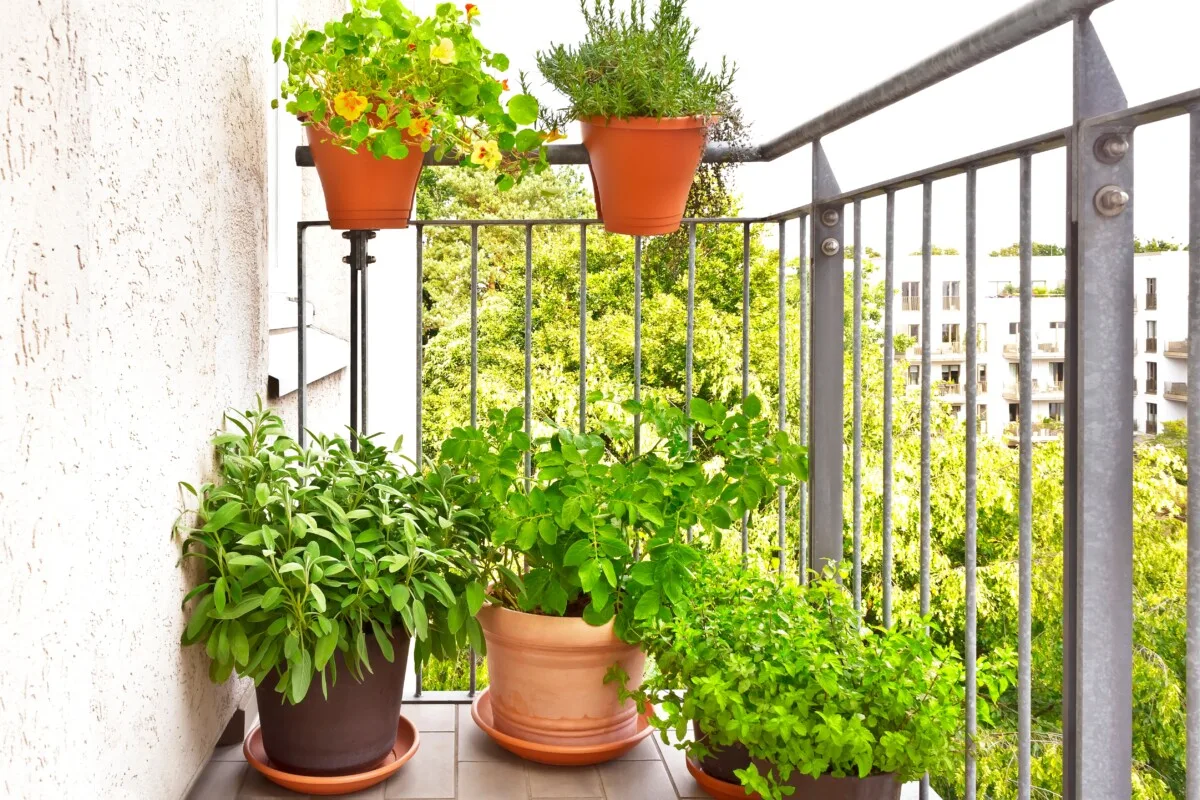
Set them out on a sunny patio, porch, or balcony, and you can get loads of fresh produce out of the smallest of spaces. It’s definitely a bonus that your potted plants can be moved around as you see fit.
Ah, but no gardening system is totally perfect. The trade-off for gardening in containers is you’ll be growing plants that will be much more dependent on you to see to their every need.
Growing plants inside planters is like creating a microclimate in each and every pot. Unlike gardens in the ground, potted plants don’t get the benefits of unrestricted root growth, insulation from the surrounding earth, or the incredibly helpful activities of soil microorganisms.
All in all, gardening in containers is way less forgiving.
Forget to water for more than a couple of days, and you better believe your plants will show you their displeasure! The drama of wilting plants and the mad rush to revive them is like a rite of passage when you grow plants in pots.
Keeping to a daily – or every other day – watering schedule can get old really fast. Doubly so once you hit the 3-month mark, and you’d like not to be tethered to your container garden all summer long.
One smart way to lighten the mental and physical load of caring for your leafy dependents is to use a more passive irrigation system – the self-watering planter.
How Do Self-Watering Planters Work?
A self-watering planter is just a fancy way of saying that your pot is equipped with a reservoir of water that slowly supplies moisture to plant roots as they need it.
Rather than drenching plant soil and letting it dry out before soaking it again, a self-watering planter maintains consistent soil moisture. As the soil in the container begins to dry, water is wicked from the reservoir, where it spreads throughout the soil.
The reason self-watering planters work as they do is a little process called capillary action.
You see this natural phenomenon any time you wet the corner of a paper towel, and water is absorbed and drawn up through the rest of the sheet. This same wicking action is also how candles, oil lanterns, and fountain pens disperse fluids. Capillary action is capable of defying the force of gravity to move liquids upwards.
In the plant kingdom, the capillary effect is how a 100-foot-tall tree can draw up water from the depths of the earth and transmit it up to the very top of its canopy. Or, when we water plants from the bottom and water in the saucer is pulled up into the soil after a few minutes.
By harnessing the power of wicking with self-watering planters, you can knock a sizeable chore off your daily to-do list. It certainly makes our lives easier, but it also makes for happier plants.
4 Benefits of the Self-Watering Garden
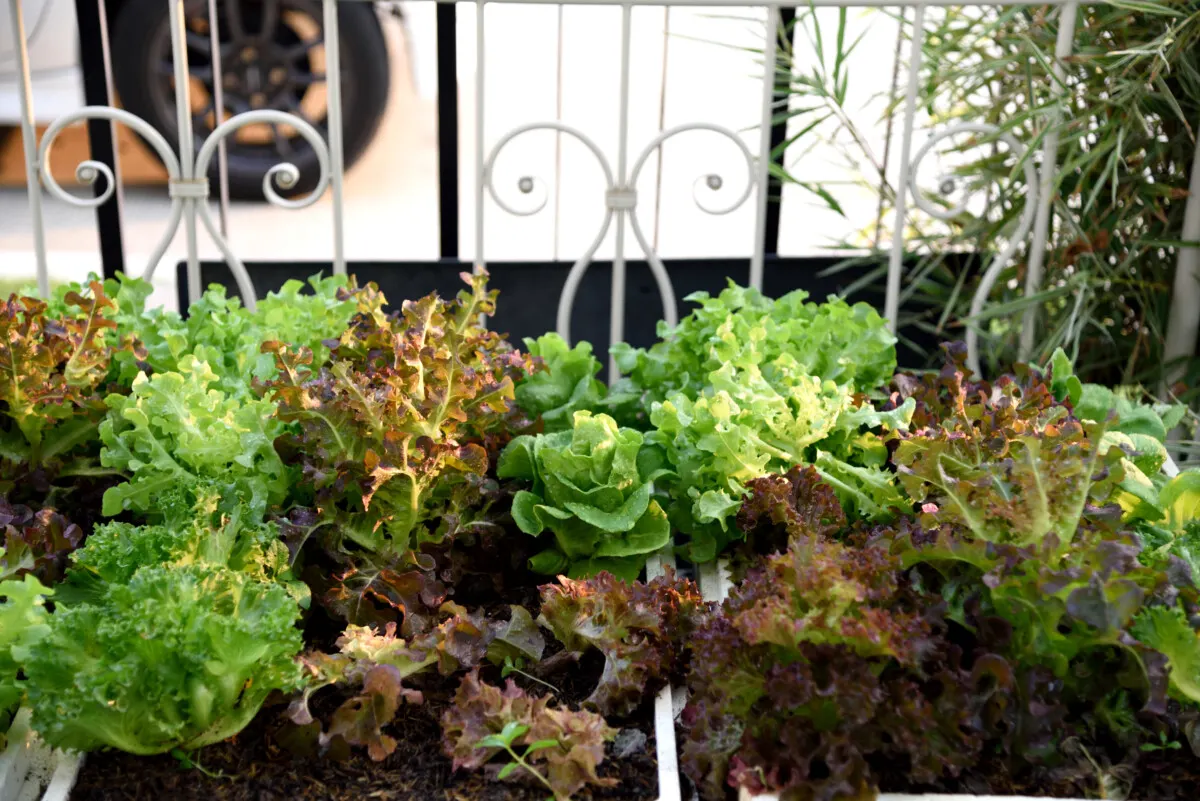
Self-watering planters have more to offer than saving you time and effort:
1. No more over or under watering
Self-watering planters are as much a boon for lazy and forgetful gardeners as they are for the most overzealous of plant parents.
The slow release of moisture in self-watering planters ensures the soil is never too wet or too dry. It takes all the guesswork out of the equation – all you need to do is top up the water reservoir once every week or two.
2. Less stress for everyone
Seeing your plants all sad and droopy is super stressful – for both of you!
Most plants are forgiving, though, and will quickly bounce back from the occasional over or under-watering.
Repeatedly swinging back and forth from extreme dehydration and rehydration will shock your plants into survival mode. And if it happens frequently, there will come a point where the plant will give up and die for good.
Self-watering planters will put a stop to the cycle of feast and famine. With continuous moisture, your plants will be in the happy middle and can focus their energies on the important stuff – you know, like leaves, flowers, and fruits.
3. Healthier plants and better yields
Tomatoes are thirstier than beans or peas. Lettuce needs more liquids than chives. Basil more than daisies.
The fruits and vegetables you grow in containers will have differing water needs. Larger plants will slurp up more than smaller ones. Younger plants and seedlings require less water at first, but will need more fluids as they pass certain developmental milestones.
As a general rule, fruits and veggies have much higher water requirements than ornamentals and herbs.
Fruiting plants, especially, need ample water supply. The demand is highest when they reach the flowering and fruit production stage. Considering fruits have over 90% water content, it makes complete sense that the plumpest and juiciest fruits are produced when plants have steady access to water.
Uninterrupted water supply is one of the greatest advantages of self-watering planters.
It certainly beats grinding out the summer months with a soil-caked finger on one hand and a heavy watering can in the other. Simply keep the reservoir topped up, and your fruits and veggies will be healthier and more productive all the while.
4. More freedom of movement
Even the most dedicated plant parents need a break sometimes. But as you know, our potted plants are extraordinarily needy. Leaving for more than a couple of days at a time risks having a container garden graveyard upon your return.
Self-watering planters will buy you time, so you can get the heck out of dodge and enjoy the most gorgeous days of the year.
How long you have away from home depends on the size of the reservoir. Most will give at least a week’s reprieve, but the largest ones can grant you a leave of two weeks or more.
What Foods Can You Grow in a Self-Watering Planter?
Luckily, most of the fruits, veggies, and herbs you would ordinarily grow in containers will positively flourish in a self-watering planter setup.
The main thing to keep in mind is whether the cultivar is a moisture-lover – and so many of the container garden mainstays are just that.
Tomatoes, peppers, cucumbers, strawberries, blueberries, potatoes, eggplant, carrots, onions, lettuce, and beans are some of the fruits and vegetables that adore a consistently moist soil environment.
Look for compact varieties, such as dwarf, determinate, and bush types, and don’t bother planting up sprawlers like pumpkins, squash, and watermelon.
Plant varieties that hail from dry climates are the ones you’ll want to avoid growing in a self-watering container. This includes desert plants like prickly pear, cacti, and succulents, of course.
Some herbs – notably basil, mint, parsley, and lemon balm – love wet feet. But others, like rosemary, sage, oregano, thyme, and lavender, do not appreciate consistent moisture at all. Because these herbs need the soil to dry out between waterings, it’s best to keep them in regular pots.
5 Best DIY Self-Watering Planters
Switching to a self-watering planter system doesn’t mean you have to toss away your beautiful collection of pots and planters.
1. Wine Bottle Waterer
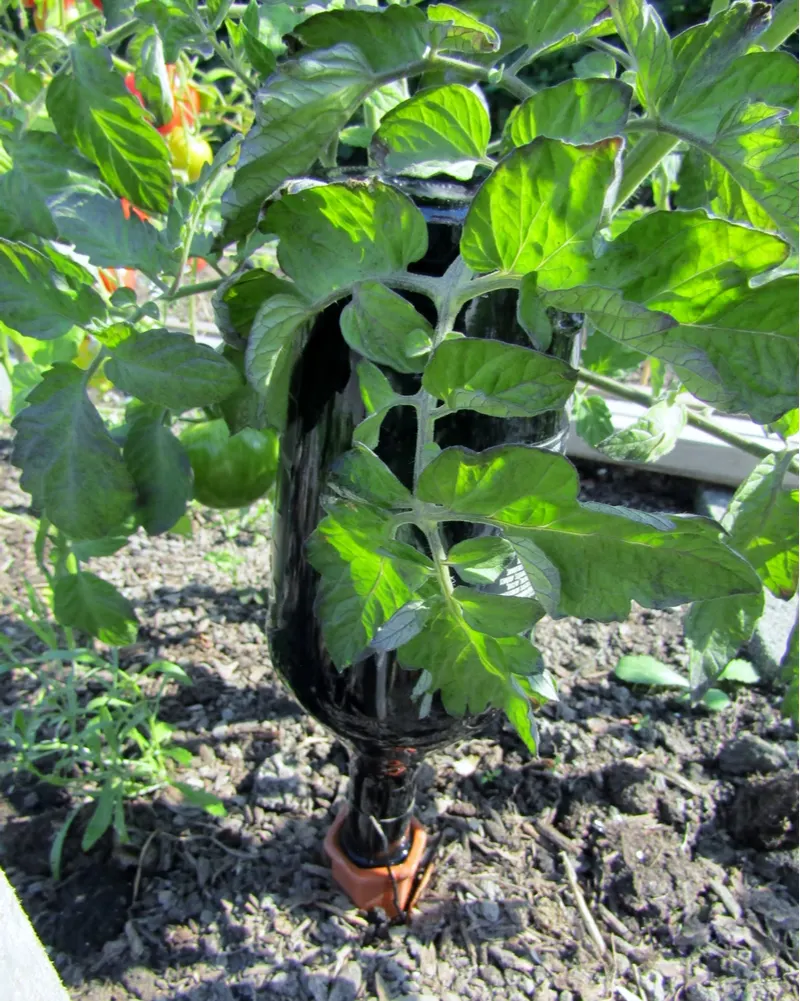
Perhaps the simplest way to upgrade an existing planter into a self-waterer, this 5-minute project is handy when you want to take a spontaneous, last-minute trip.
All you need is a clean and empty wine bottle with a cork or screw-top cap. Use a nail or screw to poke a hole through the lid. Fill the bottle up with water and stick it, neck down, into the soil at a roughly 45-degree angle.
A standard 25-ounce wine bottle will keep a medium-sized pot moist for about 3 days. Need more time? Add a second wine bottle waterer to the opposite side, or use a larger magnum-sized bottle to double your away time.
Get the DIY here.
2. Pretty Self-Watering Pots
There’s no shortage of tutorials on how to make a self-watering planter out of a plastic tote or 5-gallon bucket. As practical and utilitarian as they are, you might want something that’s a little easier on the eyes, especially if it’s going to be right next to you on the patio.
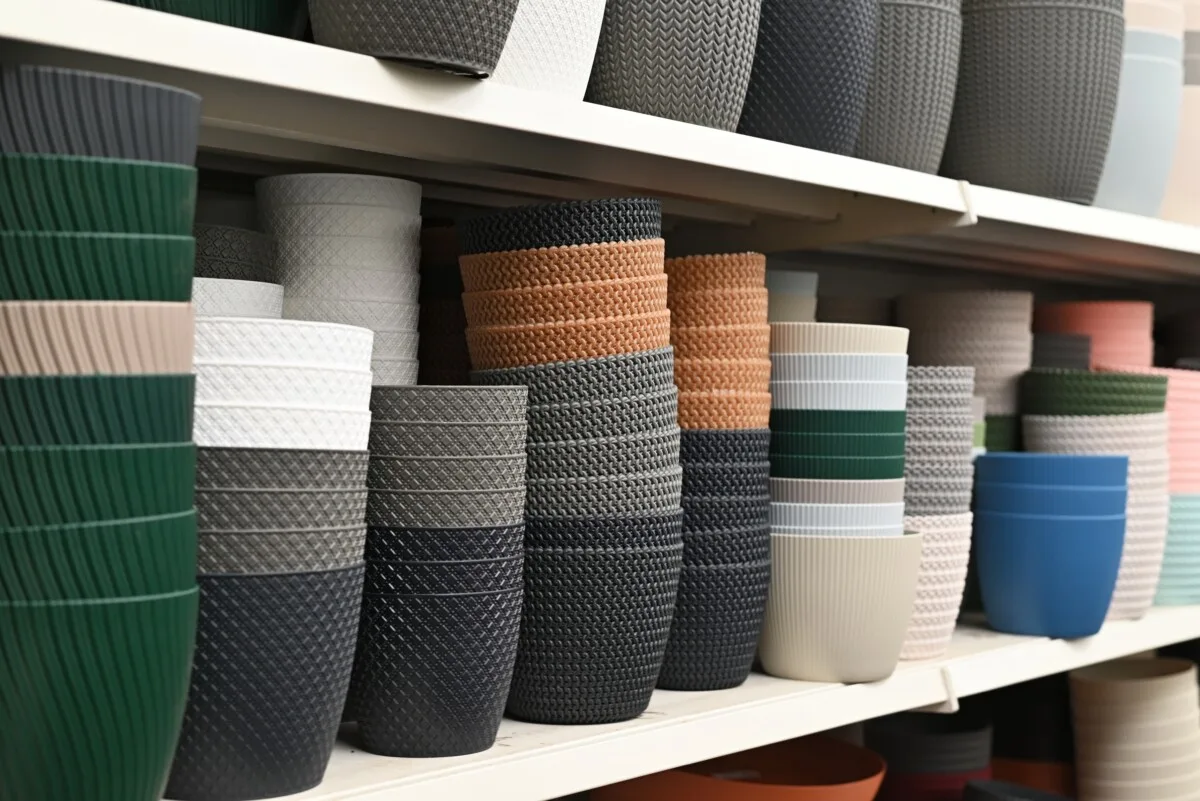
This DIY will walk you through how to make a self-waterer out of any planter you have and love. You’ll need a sturdy plastic plant saucer that fits snugly inside your pot, a 1 or 2-liter plastic bottle drilled all over with holes, and a length of PVC pipe that will poke about 2 inches above the soil.
The saucer, flipped upside down, will separate the soil above from the water reservoir below. A hole is cut out in the center of the saucer to accommodate the wicking bottle, which will draw up the water from the reservoir. Another hole is cut along the edge of the saucer where the PVC watering tube will be inserted. Then you’ll need to add a drainage hole to the side of the container, just below where the saucer sits.
Once it’s all set up, pack the wicking bottle with soil first and then the rest of the pot. Add your plants and fill up the water reserve using the PVC tube.
Get the DIY here.
3. Self-Watering Galvanized Tub
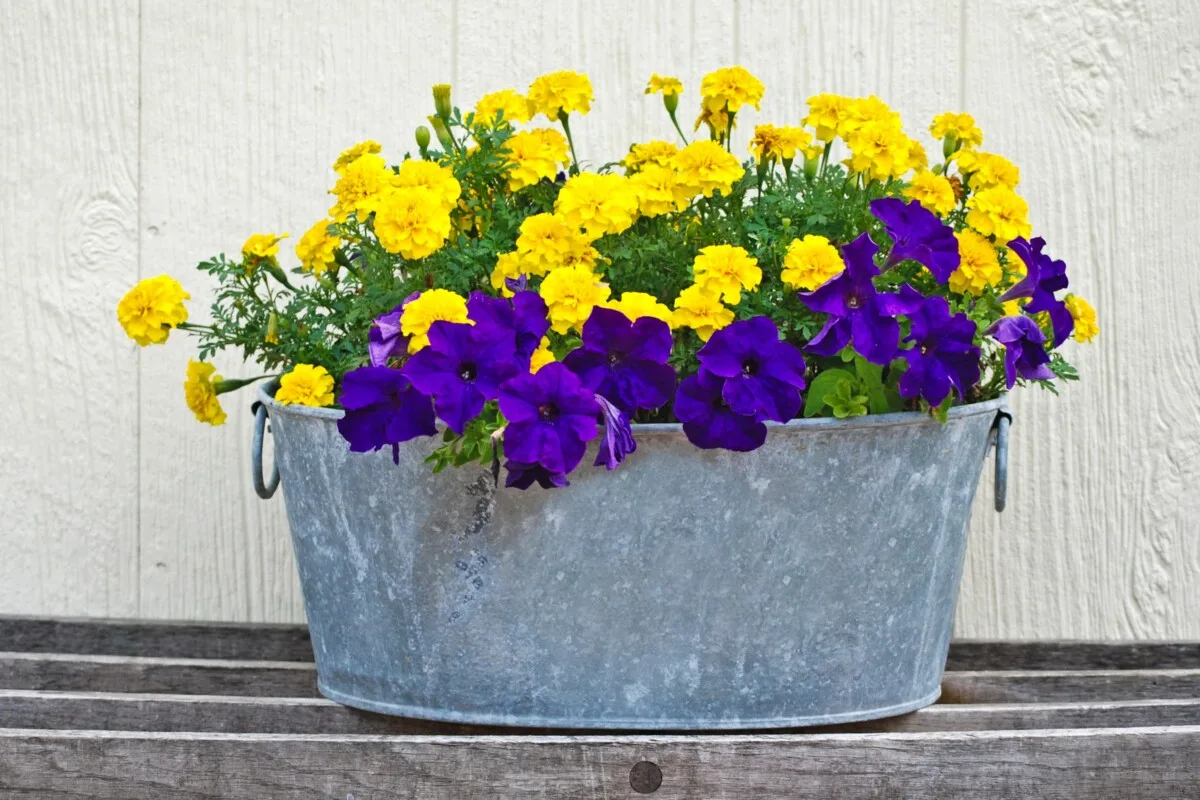
Another aesthetically pleasing DIY is the galvanized tub self-watering planter – although this tutorial could be easily adapted for any trough-style planter you have.
It works in a similar sub-irrigation fashion. A plant flat, cut to size, is what separates the soil from the water reserve. Holes are cut in the center of the flat (for the flower pot wicking chamber) and the corner (for the PVC watering tube). Drill a few holes into the side of the container to allow excess water to drain.
Cover the separator with landscape fabric, making a couple of slits in the fabric over the wicking container hole. Fill up the flower pot with moistened soil first before adding the rest to the tub.
Get the DIY here.
4. Wooden Sub-Irrigation Planter
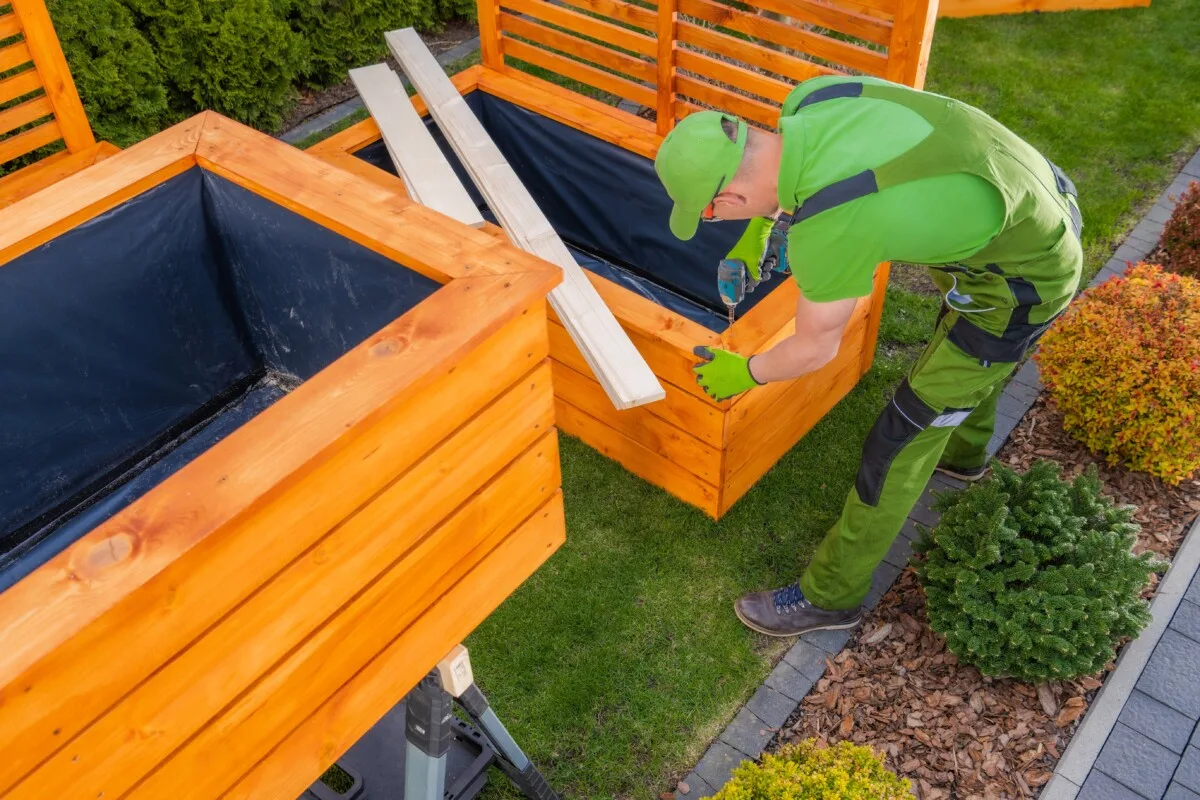
You would never know these stunning wooden planters have a secret self-irrigation system hidden within.
Any wooden planter or box can be converted into a wicking bed, but this DIY will take you through the steps of making a 3’ x 6’ bed from scratch.
The self-watering system uses a series of perforated drain pipes to separate the soil and house the water reserve. The pipes are covered in fabric sleeves to keep the soil out, but you could use a sheet of landscape fabric instead.
The inside of the box is protected with thick plastic liner before the drain pipes are wedged tightly along the bottom. At one corner, a PVC pipe is inserted into the drainage pipe as the water fill tube. On the opposite end, another hole is made into the side of the box for drainage.
Get the DIY here.
5. Self-Watering Raised Beds
The larger the planter, the more water-holding capacity it will have. In this raised bed self-watering system, weeks and weeks can pass by without the need to manually irrigate.
Using a 4’ x 8’ wooden raised bed frame, the first step is to staple a layer of thick plastic sheeting to the inside of the bed.
Next, 12 inches of smooth river rocks are dumped into the bottom of the bed. A length of PVC tubing is inserted into a hole drilled into the side of the bed, just above the rocks, as an overflow pipe. A perforated drainage pipe, about 28 inches long, is nestled into the rocks as the watering tube.
Landscape fabric is laid over the rocks to act as a barrier and prevent soil from seeping into the reservoir. Fill the bed the rest of the way with rich soil, and it’s ready to be planted up.
5 Best Self-Watering Containers to Buy
Ranging from budget-friendly to splurge options, these complete self-watering planter kits only need to be assembled.
1. HBServices 12” Self-Watering Pot

At first glance, this self-waterer looks like any regular planter. But hidden by the deep saucer – which holds about 2 weeks’ worth of water – are four hollow legs for wicking.
When filling the planter up with soil, make sure you fill up the legs, too, so you’ll achieve good capillary action.
Available in 4 sizes and in 5 colors, the self-watering pot comes with a detachable water spout for the saucer, so you don’t need to lift up the plant each time to top up the water level.
Buy it here.
2. Gray Bunny 10” Self-Watering Hanging Basket

Hanging baskets are a great way to increase your growing area. You can successfully raise an assortment of edibles (at least 37 fruits, veggies, and herbs, to be exact) up in the air.
The trouble with growing produce in hanging baskets is how quickly the soil dries out. Instead of watering them every day, a self-watering basket will allow you to scale back your watering routine to once per week.
These hanging baskets by Gray Bunny have an attractive faux rattan texture on the outside and a perforated inner bowl on the inside. The base of the basket holds the water while the 3-point wicking system keeps the upper soil chamber nice and moist. There’s a water level indicator, too, so you can see right away when you need to add more water.
Buy it here.
3. Earthbox Terracotta Garden Kit

To grow tomatoes, blueberries, eggplant, cucumber, and other larger specimens, you’ll want to give them a good bit of space in the container.
This self-watering trough by Earthbox fits the bill. It measures 29 inches long, 14 inches wide, and 11 inches deep, with a water reservoir that holds up to 3 gallons.
The kit includes almost everything you need to get started: the container, separator screen, water fill tube, organic fertilizers, two mulch covers, and four castors so you can wheel it about. All you need to bring to the table is the soil and the plants.
Buy it here.
4. Bio Green Self-Watering Planter with Trellis

Another excellent option for keeping unwieldy tomatoes, cucumbers, and other vining plants neat and tidy is the Bio Green City Jungle System.
The planter is 24 inches long, 13 inches wide, and 63 inches tall with the trellis cage. The container holds 4.5 gallons of water below and 9 gallons of soil above – making it roomy enough for your deepest-rooted plants.
It comes equipped with a water level indicator, so you know when it’s time to irrigate. Use the fold-down spout to pour water directly into the reservoir.
Buy it here.
5. CedarCraft Self-Watering Elevated Planter

With so many self-watering planters constructed from plastics, the CedarCraft elevated bed really stands out from the rest.
Made from untreated western red cedar wood, the raised bed is 30 inches tall, so you can readily care for your lovelies without needing to bend or squat. The planter itself is large enough to house several fruits and veggie plants, measuring 49 inches long and 23 inches wide.
Tucked beneath the planting box is a sub-irrigation system with an impressive 6-gallon reservoir. It includes a fill tube, water level indicator, overflow drains, and 8 wells of awesome wicking action.
The tongue-and-groove construction makes it a cinch to assemble without any tools.
Buy it here.

Get the famous Rural Sprout newsletter delivered to your inbox.
Including Sunday musings from our editor, Tracey, as well as “What’s Up Wednesday” our roundup of what’s in season and new article updates and alerts.

